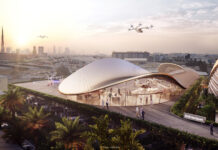By Nadim Kawach www.business24-7.ae
The UAE economy expanded by around 1.3 per cent in 2009 and growth is projected to remain subdued in the short and medium term, although it could be better than in many other countries, the Ministry of Economy has said.
 Stronger oil prices and a surge in public spending to an all-time high in 2009 kept the Arab World’s second largest economy on track in 2009 and growth this year will largely depend on the level of crude prices and the UAE’s oil output.
Stronger oil prices and a surge in public spending to an all-time high in 2009 kept the Arab World’s second largest economy on track in 2009 and growth this year will largely depend on the level of crude prices and the UAE’s oil output.
In a 100-page report analysing the country’s 2009 socio-economic and financial indicators, the ministry said there had been numerous forecasts by international and regional organisations about growth prospects in the UAE for 2010, ranging from as low as 0.6 per cent to nearly 3.2 per cent.
At the official level, the latest estimates of real GDP growth have ranged between 1.5 and 3.2 per cent, as forecast by the UAE Central Bank and the Ministry of Economy respectively, the report said. It attributed the relatively wide disparity in GDP forecasts to the different weights attached to various drivers of growth in the UAE.
Oil price factor
Chief among these is the oil price, which is expected to average about $70-90 in the short run, given the recovery in the global economy, especially in Asia, which is expected to boost the regional demand for oil by four per cent in 2010-2011.
The UAE also plans to pump more oil to meet this extra demand as recently announced by the Abu Dhabi National Oil Company (Adnoc), although it was agreed at the most recent Opec meeting in Vienna that production quotas will remain unchanged to maintain the current “fair” $70-90 price.
The report said global recovery could also have a positive effect on the UAE’s non-oil GDP as it could expand by one to 1.5 per cent this year after slowing to one per cent in 2008. Non-oil GDP growth soared to eight per cent in 2005-2007.
In the medium and long runs, the UAE will leverage its excellent infrastructure, both soft and hard, to meet the regional demand for services and logistics, especially in Dubai, where trade, logistics, and financial services have been slowly replacing real estate activities, the report said.
Tourism is also beginning to rebound from its lows in 2008-2009, and large infrastructure projects such as the Dubai Metro, Burj Khalifa, Al Maktoum International Airport, Dubailand, the Yas and Saadiyat Island developments in Abu Dhabi, and many others will definitely attract more tourists as the global recovery gains momentum in the coming few years.
In addition to these drivers of growth, the Ministry of Economy has just started to implement initiatives to diversify the economy in line with the National Charter 2021 by promoting growth in industry, entrepreneurship, small and medium enterprises, renewable energy, and many other sectors to help build a competitive economy and create a highly attractive business environment.
Low-key growth
“Against this positive background, the growth prospects of the UAE are somewhat subdued due to weaknesses in the global economic recovery and the slowdown in the real estate sector, which has traditionally taken much longer to recover than other sectors,” the report said.
“Some observers have argued that the delays associated with the Dubai World debt restructuring process will have a negative impact on growth since foreign banks and investors are reluctant to invest under this uncertainly… but as stated on more than one occasion, the federal government stands ready to support individual emirates although the growing role of the government in the day-to-day operations of a market-type economy is not to be encouraged as demonstrated by the ‘exit strategies’ of many governments in high-income countries.”
For this reason, the report noted, GDP growth prospects of the UAE will be more favourable than high-income countries in advanced economies but will lag behind other emerging economies, especially in Asia, in the short to medium terms. “Moreover, the current low rate of inflation has worked to the advantage of the domestic economy by lowering the cost of production and improving the competitiveness of the economy,” it said.
GDP growth in 2009
In contrast with most other regional and international estimates, which showed the UAE’s real GDP contracted in 2009, the Ministry of Economy said it expanded by around 1.3 per cent due to growth in the non-oil sector.
The report showed the non-hydrocarbon sector surged by about 8.3 per cent while the oil sector slumped by nearly 12.7 per cent because of a cut of more than 200,000 bpd in the country’s crude output in line with a collective agreement by the 12-nation Opec to trim supplies to keep prices firm.
In current prices, the UAE’s GDP shrank by around 2.1 per cent to Dh914.3 billion in 2009 from a record Dh934.3bn in 2008 mainly because of a decline in oil prices to an average $60 last year from about $95 a barrel in 2008. The report noted that the economy maintained its upward trend in 2009 largely due to a massive increase in public spending despite lower oil export earnings.
From around Dh254bn in 2008, the consolidated financial account, involving the federal budget and spending by each emirate, grew by nearly 14 per cent to a record high of about Dh289bn in 2009.
“This increase in government expenditure occurred at a time when government revenue fell by a massive 35 per cent from Dh450.3bn in 2008 to Dh292.6bn in 2009 due to lower oil prices and losses in investments abroad.”
Fiscal expansion
The ministry warned that a continuation of the expansionary fiscal policy triggered by the global crisis could stoke inflation again.
“These expansionary policies have the potential to create inflationary pressures as economic activity picks up and profitability increases, especially in the subdued real estate market with the potential of creating renewed bubbles. The global economic recovery, especially in China and more recently in the US, has also put upward pressure on oil prices with potential inflationary effects on the UAE as oil revenues are increased further resulting in large capital inflows which would increase liquidity and drive consumer spending and investment,” it said.
“For all these reasons, the authorities must be careful in their exit strategies by ensuring that an appropriate dose of stimulus is given to the economy such that inflationary pressures are checked and excessive spending is restricted.”
The report noticed what it described as some indications that inflation is exhibiting an “increasing trend as reflected in the increase in the global price of basic foodstuffs, steel, and building materials which will lead to higher UAE import bill, which, in turn, will be reflected in a rise in domestic prices”.
“Taking into account these developments, the rate of inflation is expected to be above the level estimated at 1-1.5 per cent by the end of 2010.”
In its latest forecasts about the UAE released yesterday, the Saudi American Bank Group (Samba), said the country’s economy is recovering despite the eurozone crisis.
It projected real GDP growth in the UAE at around two per cent this year, adding that the private sector remained stifled by tight bank credit. “Despite the recent turmoil in financial markets the global economy is recovering, and while European growth may falter, we do not think financial strains will spill into a double dip global recession. In this context, oil prices are still expected to average $75 this year and $80 next. This will help support strong oil revenues and bolster confidence in the UAE,” Samba said.
“While Abu Dhabi’s oil wealth will support sustained public investment activity, limited credit availability will constrain private sector growth. The impact of the DW restructuring is likely to be manageable, but UAE banks remain concerned over deteriorating asset quality and many continue to face funding constraints.”


















